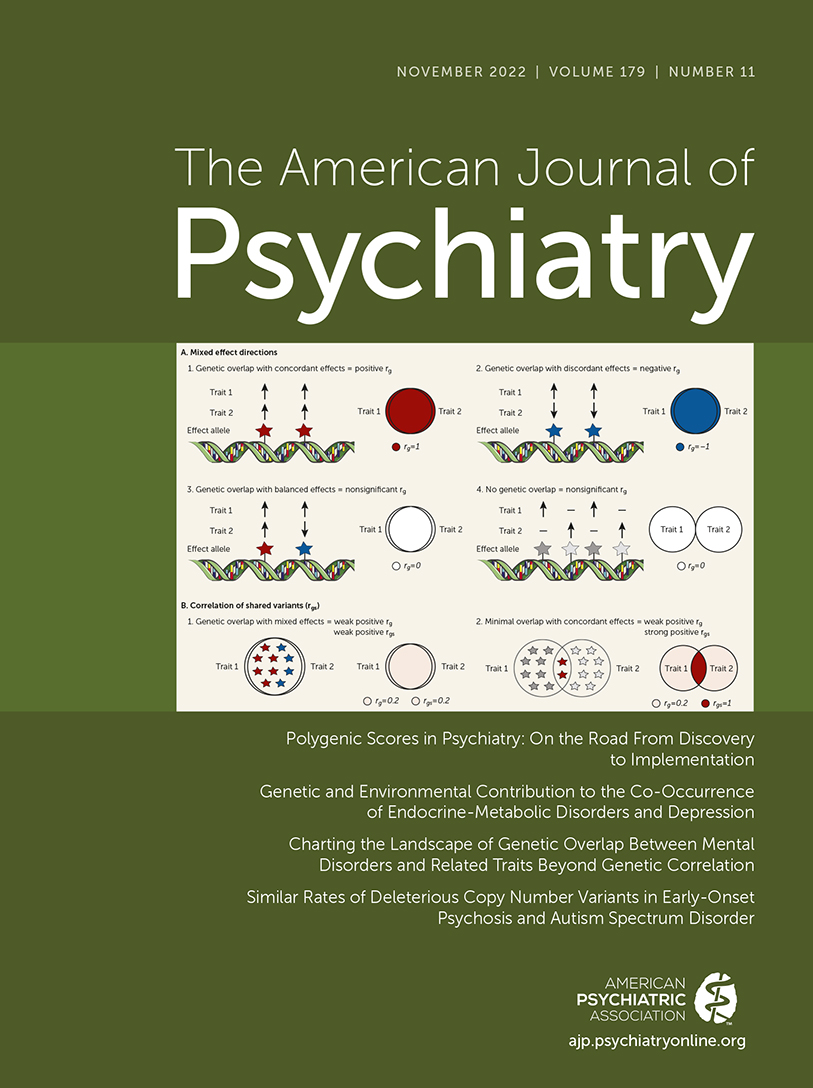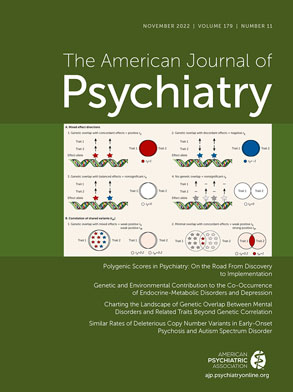A causal relationship of posttraumatic stress disorder (PTSD) and cardiovascular disease (CVD) has been long postulated, and has occasionally been examined primarily epidemiologically, but is yet to be proven. In one of its earliest descriptions, during the Civil War, the psychiatric response to war was labeled “soldier’s heart,” recognizing the acute sympathetic arousal associated with the trauma response, which is still a core component (i.e., altered arousal and reactivity) of the present DSM-5-TR diagnostic criteria (
1). In this issue of the
Journal, Seligowski et al. (
2) move us one step closer to understanding this relationship and its causal direction.
Seligowski et al. accomplish several tasks in this study. Using a new large biobank data set (N=36,412, including 2,149 with PTSD) and publicly available genome-wide association study (GWAS) data sets, they make four key observations. First, they identify significant genetic correlations between PTSD and hypertension (rg=0.35) and coronary artery disease (CAD) (rg=0.24). Notably, major depressive disorder showed similar correlations. Second, using Mendelian randomization analysis, a statistical method to assess possible causal direction using genetic rather than clinical trial data, they show that there is support for PTSD being causally linked to both hypertension and CAD. Of note, the models examining the reverse—CAD and hypertension predicting PTSD—had p values of 0.0041 and 0.0345, not quite making the Bonferroni-corrected significance threshold of 0.006, but not entirely ruling out a bidirectional relationship. Third, they find that the prediction of PTSD from genetic summary statistics for PTSD is improved by including genetic summary statistics for hypertension, CAD, and major depressive disorder (area under the curve ranging from 0.546 to 0.592, and R2 values ranging from 0.27 to 1.30). Finally, using a pathway analysis, they identify genetic variants involved in the PTSD–CVD shared risk that might be pathophysiologically relevant (i.e., postsynaptic structure, synapse organization, and immune function).
A recent National Heart, Lung, and Blood Institute (NHLBI) workshop highlighted the primarily epidemiological research, which indicates a relationship between PTSD and CVD and what is needed to move forward (
3). Three previous studies also inform our understanding of the genetics of PTSD and CVD (
4–
6). These identified candidate genes related to inflammation associated with PTSD and CVD and suggested a relationship of PTSD GWAS summary statistics to blood pressure. More recently, a study using data from the Million Veteran Program and three other public gene biobanks similarly found a genetic correlation of CAD and PTSD, ranging from 0.18 to 0.32 (
7). That study also used scores on the 17-item PTSD Checklist (PCL-17) in a Mendelian randomization assessment of causality and found a bidirectional relationship with CAD wherein genetically determined PCL-17 total score was associated with increased risk of CAD, but genetically determined CAD score was associated with
lower PCL-17 score. When electronic health records were used to examine temporal priority—PTSD prior to CAD or the reverse—these findings were recapitulated. These results are difficult to reconcile with those of Seligowski et al., but they do suggest that PTSD–CAD associations may be more complex than currently conceptualized.
Much is learned in these studies, and yet much remains hidden. So let’s step back a moment to 30,000 feet to better see the landscape and the way ahead. PTSD since DSM-5 is in a chapter separate from anxiety disorders: “Trauma- and Stressor-Related Disorders.” The new chapter highlights that other trauma-related disorders are known and others will be found. The criteria, as for many years, begin with the exposure to a traumatic event. Also, there are now DSM-identified subtypes of PTSD—in particular dissociative subtype—and more can be expected. Additionally, recently added to the core symptoms is negative alterations in cognitions and mood. Note that this is positioned as a core symptom, separate from the well-known comorbidity with major depressive disorder (and substance abuse), although recent research using polygenic risk scores suggests that a genetic link with major depression is likely (
8).
But what is PTSD—how is this construct organized? One can think that PTSD is a reset of a core response capability of the brain. Just as an engineer could tell us the equation at which steel would bend at room temperature—one set of environmental conditions—she would give us a very different equation for how it would bend at zero degrees Kelvin, a reset of how steel bends in this new environment. Similarly, is the neuropathology of PTSD a “reset” from one environment of expected safety to a more frightening and dangerous world? The brain’s “equations of function” have changed. We state that PTSD is present only when all four of the core symptoms are present, namely, intrusion, avoidance, negative cognitions/mood, and altered arousal and reactivity. Left undefined is what that means. All symptoms present in 1 day, 1 week, 1 month? Leaving that aside, for someone who only has one or two of the symptoms, we do not diagnose PTSD. So is PTSD, at its core, not the symptoms at all, but actually the “glue” that makes the symptoms stick together, occur together? But then we also know that PTSD can come from exposure to death and the dead—for police, firefighters, body handlers, disaster workers. When this exposure is accompanied by thoughts of “It could have been me,” “It could have been my sister,” and the like, the risk of PTSD is increased manyfold (
9). Identification and emotional involvement with the dead increases risk. But identification is usually a health-promoting cognition. We identify with mother, father, and those we admire. So identification has “turned against the body,” much as an autoimmune disorder is the result of our own immune system attacking our body. Inflammation, a necessary part of recovery from infection, can be seen similarly, and it is probably no coincidence that PTSD is strongly associated with autoimmune and neuroinflammatory conditions (of which CAD may be one) (
3).
So why do these distinctions matter? Without a single model for PTSD, we work with several in animal models to better understand the neurobiology. Recent studies of PTSD brains and regional omics also inform our way forward (
10,
11). But PTSD has many facets (and some will be identified as subtypes). Also, we know one must first be exposed to a traumatic event to be at risk for PTSD. Trauma exposure itself has a heritable basis (
12), but this has only recently started to be considered in most of our genetic approaches to PTSD (
13). The fact that PTSD has a number of symptoms, so that any scale that measures symptoms may be measuring some but not all PTSD symptoms in any given person, may both inform and confound our studies as we compare some people who have high intrusion, avoidance, and negative cognitions with others who have high intrusion and arousal. Whereas GWAS findings suggest that PTSD symptom subdomains are highly genetically correlated (
14), this observation does not discount the possibility that there is something biologically important about having multiple symptoms (i.e., the glue). Also we know that PTSD is often comorbid with other medical disorders related to CVD, from diabetes to insomnia (
15,
16), and some of these precede the onset of PTSD. Is the association of PTSD and CVD direct or through multiple associated comorbidities, or more likely both? Are these the mechanism of the associations of PTSD and CVD? Our genetic work, although amazing, is still at a point where our power to make causal inferences is limited with regard to the very complex phenotypes we deal with in psychiatry. Larger samples will help, and statistical power will also grow with diverse ancestries (
17). Our animal models for PTSD are numerous, attempting to replicate elements of the disorder. But there is no model that captures all symptoms. Similarly and importantly, as discussed in the NHLBI conference (
3,
4), our way forward needs to include animal models of comorbid PTSD and CVD to better inform the street lights we look under.
The study by Seligowski et al. not only informs and entices us to learn more about PTSD and CVD but also indicates that we are on the right road and that we can continue in the adventure. It will help our patients and our understanding of brain and heart.

